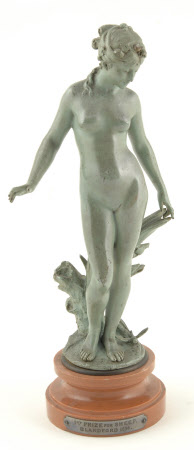Girl surprised by a dragonfly
Auguste Moreau (Dijon 1834 - 1917)
Category
Art / Sculpture
Date
c. 1894
Materials
Pale green patinated zinc
Measurements
290 mm (H); 135 mm (W); 90 mm (D)
Place of origin
Paris
Order this imageCollection
Kingston Lacy Estate, Dorset
NT 1257631
Summary
Sculpture, probably bronze; Figure of a young girl with a dragonfly; Auguste Moreau (1834-1917); c. 1894. A bronze figure of a young girl, by the late nineteenth-century French sculptor Auguste Moreau. A member of a dynasty of sculptors from Dijon, he specialised in small sculptures, often featuring young women and children. This particular sculpture was awarded to a member of the Bankes family, presumably Walter Ralph Bankes (1853-1904), as the first prize in a sheep competition in Blandford, Dorset in 1894.
Full description
A figure of a young girl who stands naked, her hair carefully done up at the back, roses and other flowers woven in to the tresses. Holding with her left hand onto a frond of a water reed plant that grows behind her, she is evidently depicted on the point of entering water to swim. However, her attention has been caught by a small dragonfly that has alighted on the ground next to the left foot of the girl, who slightly raises her right hand in surprise. The sculpture is signed on the base, which is separately cast, the two elements joined by screws and nuts. The base certainly seems to be made from bronze, so the figure is probably also made of bronze rather than spelter, an alloy of zinc and lead that was often used for later nineteenth-century statuettes. The service of the figure has been coated in a green lacqueur, now concealing most of the raw metal surface. The sculpture is the work of Auguste Moreau (1834-1917), but has until recently been incorrectly attributed to another contemporary French sculptor, Augustin-Jean Moreau-Vauthier (1831-1893). Moreau-Vauthier's subject matter and style were not very different to that of his near namesake and, in order to distinguish himself from other sculptors bearing the name Moreau, he began from 1865 to sign his works in the longer form Moreau-Vauthier. The girl with a dragonfly on the other hand, which dates from the early 1890s and clearly bears his signature, must therefore have been made by Auguste Moreau. He was the youngest of three sons of Jean-Baptiste Moreau (1797-1855), a sculptor and painter from Dijon. Both Auguste’s older brothers Mathurin (1822-1912) and Hippolyte François (1832-1927) also practised as sculptors, as did Auguste’s sons Louis Auguste (1855-1919) and Hippolyte (1857-1930). Auguste first studied with his older brother Mathurin and first exhibited at the Paris Salon in 1861, from then on exhibiting regularly at the Salon until 1913. All three Moreau brothers worked in a similar style, producing well-modelled but often sentimentalising figures of young women and of children. Other works by Auguste Moreau in National Trust collections include a pair of large putti holding lamps at Ickworth (NT 850836). His figures, which were generally signed, frequently appear at auction. Just two recent examples are a bronze group of two children offered at Hatton Garden Auctions Ltd, London, 22 January 2024, lot 2500, or a large bronze figure of Cupid with Curated Auctions, London, 18 January 2024, lot 101. Another cast of the girl with a dragonfly was sold at auction in France, in Semur-en-Auxois in 2021 (Alexandre Landre, 25 September 2021, lot 379). The subject of young girls depicted either with a dragonfly, as here, or else sporting little wings as a humanoid version of these insects, became quite popular in later nineteenth-century French sculpture. Among the better-known works by Mathurin Moreau was his large bronze figure of a water nymph with dragonfly wings that surmounts the fountain in the centre of the place du Théatre-Français in Paris. In the twentieth century, the British sculptor Elisabeth Frink (1930-1993) reprised the subject in her bronze figure of a dragonfly man, conceived in 1965. So far as the figure now at Kingston Lacy is concerned, there is a certain irony in the notion that this titillating escapist sculpture, very distant from the tough realities of rural life for most people in late nineteenth-century Dorset, as depicted in the novels of Thomas Hardy, should have been chosen to serve as the first prize in such an eminently rural event as a champion sheep competition, held in Blandford in 1894! Jeremy Warren January 2024
Provenance
Probably Walter Ralph Bankes (1853-1904); by descent to Ralph Bankes (1902-1981), by whom bequeathed in 1981.
Marks and inscriptions
Signature, on base:: Augte Moreau Brass label fixed to base:: 1ST. PRIZE FOR SHEEP./ BLANDFORD 1894.
Makers and roles
Auguste Moreau (Dijon 1834 - 1917), sculptor Augustin-Jean Moreau-Vauthier (Paris 1831 - Paris 1893), sculptor
References
Kjellberg 1987: Pierre Kjellberg, Les Bronzes du XIXe siècle. Dictionnaire des Sculpteurs, Paris 1987, pp. 505-08
